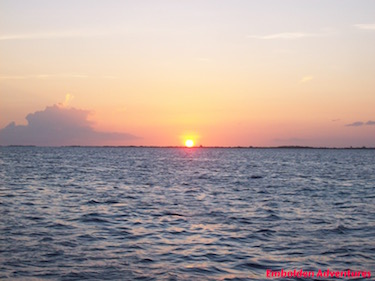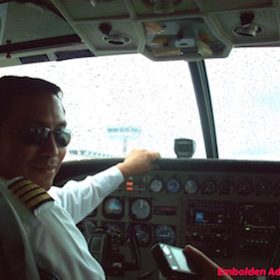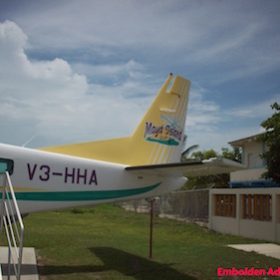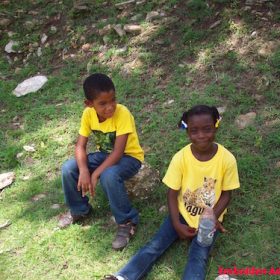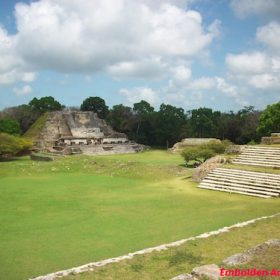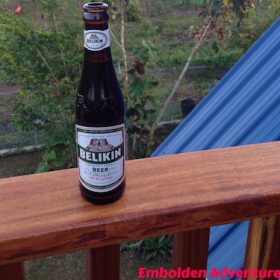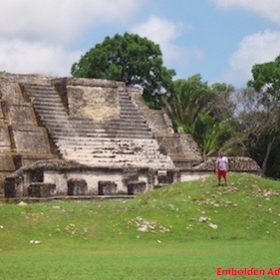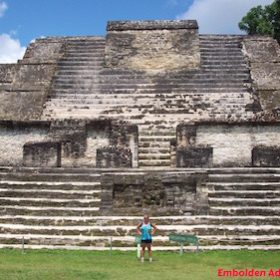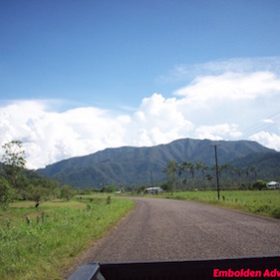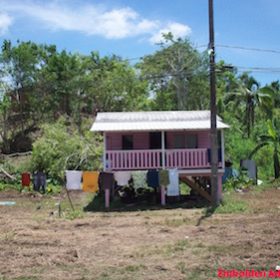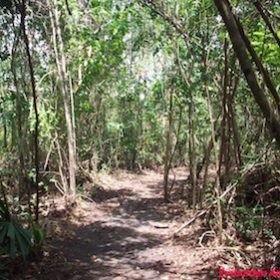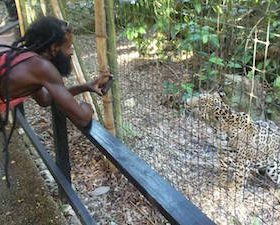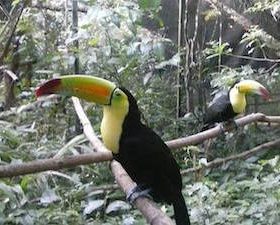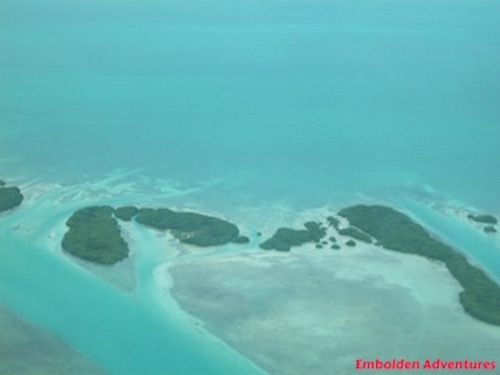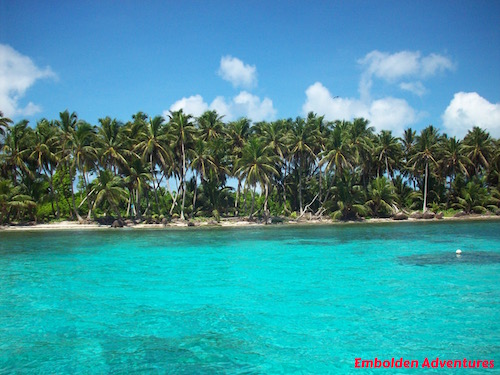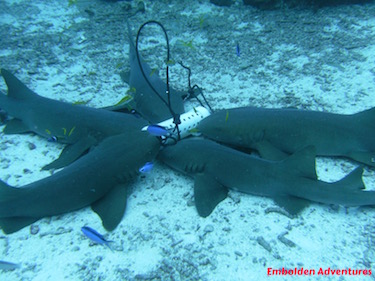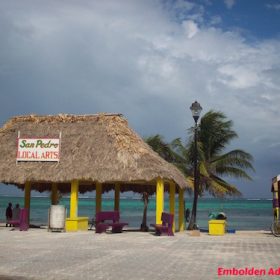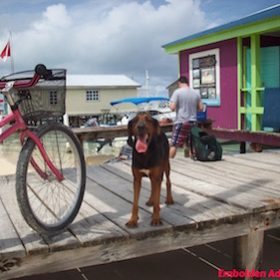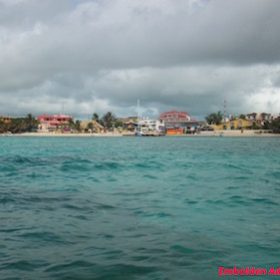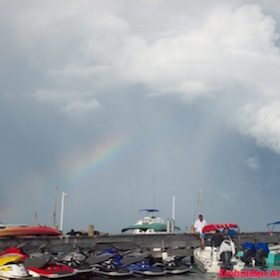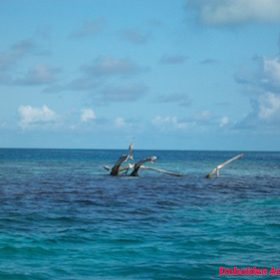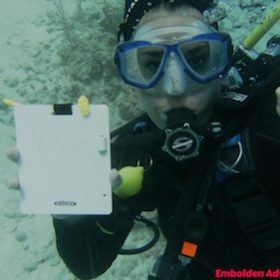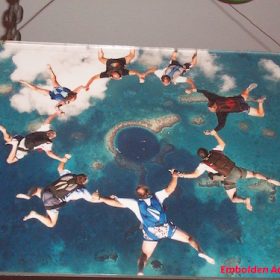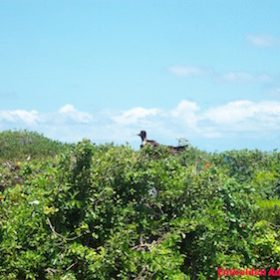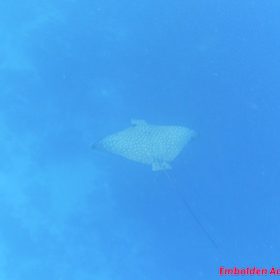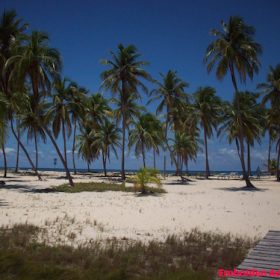By land or by sea, Belize is a tropical destination that provides a diverse travel experience including:
- Ambergris Caye and its relaxed Caribbean island feel
- Ancient Mayan temples
- Blue Holes – a fresh water one in the jungle and the famous one in the ocean
- A bird sanctuary on a remote island caye
- Spooky limestone caves explored by river tube
- A great barrier coral reef with the chance to swim with sharks
- And so much more…!
Twice now I have visited the country of Belize. My first trip was focused on enjoying the turquoise beaches on the Caribbean Sea, going scuba diving in their great barrier reef, and exploring ancient, mysterious Mayan ruins.
My second trip was focused on feeling the energy of the jungle, spending time with my friend Allie who recently uprooted her New York City life to live now in the thicket of the jungle. Listen to this podcast, Welcome to the Jungle featuring Allie right here.
Both trips showcased the beauty of Belize. This tiny country with a population of just over 360,000 people and the size of the state of Massachusetts in the United States or the country of Wales in the United Kingdom, packs in so much for the adventure traveler or the tropical beach-goer.
Know Before You Go
Belize is located in Central America, south of the Yucatan Peninsula in Mexico, north and east of Guatemala. Its entire eastern border is made up of Caribbean Sea coastline. Once called British Honduras, Belize has cultural blend of a Central American and Caribbean flavors.
English is the predominate language spoken although many Belizeans are bilingual or speak many languages including Spanish and Kriol. The people are diverse in ethnicity ranging from Mestizo, Kriol, Mayan, Garifuna, East Indian, German, and others.
Getting to Belize is fairly affordable and a quick destination by plane. Non-stop flights from as far as Toronto, New York, Los Angeles, and Chicago and as close as Miami, Atlanta, Houston & Dallas, Charlotte, Mexico, Honduras, Guatemala, El Salvador, and Panama range from one to seven hours in duration.
Most travelers do not need a visa to enter the country, but check specific information here. The country uses their Belizean dollar and accepts the US Dollar with the general conversion of 2 Belizean dollars to 1 US dollar.
Flying within the country to the island cayes (pronounced “keys”) or to the south can be done by small propeller plane. It is easy to drive around the tiny country with a rental car or even a golf cart on the cayes.
Anytime of the year is a good time to go to Belize. Keep in mind the country has Caribbean weather with the occasional thunderstorm. The rainier times are between May and November and the country rarely gets head-on impacts from hurricanes.
A lot can be accomplished in about a week’s visit depending on how adventurous or relaxed one desires to be. From snorkeling and scuba diving to trekking into the jungle, a trip to Belize could be a lot of fun. Here are some ideas of things to do and see while in Belize:
Belize By Land
Altun Ha and Other Mayan Ruins
Altun Ha is an ancient Mayan city and an archaeological site stretching over 5 square miles. It is part of the wider area of the Mayan civilization that flourished across most of Central America in southeastern Mexico, Belize, Guatemala and parts of Honduras and El Salvador from 2000BC to 1700AD.
Altun Ha translates to “stone cistern of water”. Archaeologists began excavating the area at the end of the 1960s, however, like other Mayan sites, most of the area is still hidden by the overgrowth of the jungle. The large stone temples that are visible include the Sun God Temple and the Temple of the Masonry Altar, standing at 54 feet high. The Temple of the Masonry Altar is the logo for the Belizean beer, Belikin Beer.
Tourists can walk around the grass grounds and climb the stone stairs to the tops of the temples. When we arrived in the morning, we were basically the only visitors on the grounds. Altun Ha is accessible by car or hired tour van and is located about 6 miles west from the shore and 30 miles north of Belize City.
Twenty-eight Mayan archaeological sites are in Belize with more to be discovered. Besides Altun Ha, other popular Mayan sites are Caracol located in the west near the Guatemalan border, Cerros located on the coast in the north, and Lamanai located in the northwest.
Blue Hole Cenote and Hummingbird Highway
Take a day to explore the rolling jungle mountains of Belize along the Hummingbird Highway watching the green world unfold. Riding in the back of a pick-up truck, we passed orchards, and colorful flowers of blues, fuchsias, purples and yellows, and palm trees of all heights. Horses and cows grazed in grasslands. It was a sunny day and a Central American experience at its finest.
We drove out to the Blue Hole, a freshwater cenote in the jungle. It is located at the Blue Hole National Park along Hummingbird Highway. This swimming hole had a palette of iridescent sea greens and blue colors, depending on the depth of the water and the shade from the surrounding, steep edges of the jungle. The water was a chilly cold that contrasted with the warm, humid air temperature. Taking a swim in the cenote provides a peaceful respite in the day adventure through this central part of the country.
The swimming hole is an ancient sinkhole made of limestone that collapsed downward. Fresh rainwater seeping down through the porous limestone creates an underground network of streams. This upwelling of water is what fills the Blue Hole from below. I followed a stream of water that continues past the perimeter of the Blue Hole. This stream entered into a limestone cave with very low ceilings made of stalactites.
At the edge of the cave, I peered my head inside to investigate it. I saw a bat flying around that I must have spooked with the sound of my echoing voice. This stream continued deeper into the cave. I did not feel comfortable continuing inside, so I headed back to the Blue Hole, fighting a surprisingly strong current of water.
Crystal Cave Tubing
Many areas inside and nearby the Blue Hole National Park have caves that you can explore with a guide on foot or by river tube through the water. During my first trip to Belize, we spent the day exploring the Crystal Cave and the surrounding jungle are near the Blue Hole National Park.
We hiked along the river, often times wading in the water. Here we were in the thicket of the jungle in the plethora of green vines, hearing the sounds of the birds and the rushing water.
The ancient Mayans believed the caves were the underworld where their gods resided and their ancestors passed on to. The caves connected their natural world with the supernatural world. Inside the caves the Mayans would perform sacred rituals, and today artifacts can be found inside the caves such as clay pottery and bones.
At the end of the path, a bright blue-green cenote appears. We headed down to the edge of the water and waded into the shallower part to access the inflatable tubes. We would enter inside the cave, approaching it from the moving creek. Before doing so, we interconnected our tubes with one another, linking our legs with the arms of those in front of us.
Our guide led the way through the arch entrance of the cave. It was a spooky yet exciting experience traveling through its interior.
Ambient light fades away, and the darkness of the cave surrounds us. We were able to see using our headlamps. The sides of the limestone walls glitter like diamonds. Bats hang from the roof of the cave. Our voices echoed. Water dripped down from the pointy, crystalized stalactites hanging from the ceiling. Those drops echoed too.
Soon we see a glimmer of light at the end of the tunnel. The cave opens back up to the outside world, and we cruised through the exit of the cave.
Jungle Life
Escaping to the middle of the jungle in Belize has this calming effect. The freshness of the surrounding nature and the sounds of the birds and the bugs evoke feelings of tranquility. I would recommend spending a day driving through the center of the country, stopping along the way to feel the energy of the jungle or staying through the evening in a jungle lodge.
Head towards the capital city of Belmopan along the George Price Highway. While you are there, be sure to visit Allie at her plant nursery Allie Ray Plant Nursery located on mile 40.6 on George Price Highway in Harmonyville, 10 miles outside of Belmopan. Read more about Allie and her journey to Belize here.
The Belize Zoo is located along this highway between Belize City and Harmonyville. All 48 species of animals – mammals, birds, and reptiles – native to Belize are found in the zoo such as the jaguar, crocodile, toucan, spider monkey, boa constrictor, and the tapir, the national animal of Belize.
Belize By Sea
Great Barrier Reef
The country has nearly the same length of coastline as it does with its land border with neighboring countries: 240 miles of coastline compared to 340 miles of land. Along the coast is the Great Barrier Reef, the largest coral reef in the western hemisphere and the second largest coral reef in the world behind the Great Barrier Reef in Australia. It begins north of Belize at the Yucatan Peninsula near Cancun Mexico and stretches south to Honduras.
This reef creates many beautiful island atolls and cayes of Belize. These cayes, some of them habituated, can be accessed by boat or by small plane such as Ambergris Caye and Caye Caulker. The Turneffe Atoll is where the legend of Blackbeard lives, and Lighthouse Reef atoll is home to Half Moon Caye and other picturesque, palm tree-lined cayes. Glover’s Reef is located further south.
Scuba Diving and Snorkeling
I am an avid scuba diver having dove nearly 300 dives around the world. Any chance I have to dive, I will gladly take it! Being in Belize, this trip was no exception. I was able to get in a few days and one night of diving around Ambergris Caye, off Half Moon Caye, and in the Blue Hole. Some of the dive sites I explored were Cypress, Esmerelda, Tackle Box, San Pedro Canyon, Love Tunnels, and Holchon for the night dive.
Comparing the health of these reef dives with the ones I dove in Cozumel, Mexico, also part of this Great Barrier Reef chain, I was saddened to see the difference in Belize, at least by Ambergris Caye. Overfishing and lack of protection measures made the reef seem a bit barren to me with few fish and bleached corals. The dive in Half Moon Caye had more vibrant, underwater marine diversity and healthier corals.
The underwater life found around the reef are the usual Caribbean fish such as nurse sharks, groupers, parrot fish, hog fish, angelfish, barracuda, snapper, triggerfish, sea turtles, trumpetfish, and moray eels, among others.
We explored some underwater caves and swim-throughs and participated in the nurse shark feedings. I think because of the popularity of this eco-tourist shark activity, many more nurse sharks seemed to hang around the Ambergris Caye dive sites. And these nurse sharks seem to be much more active during the day compared to those I have seen with their typically sluggish demeanors. Every time I see a nurse shark, I think of how they look like catfish with their small eyes and “whiskers” at the edges of their mouths. All in all though, nurse sharks are generally docile and are not a threat to swimmers and divers alike. This experience is worth it.
Ambergris Caye
From Belize City, we took a short island hopper plane to the village of San Pedro on Ambergris Caye, the only town on the island. Madonna’s song, La Isla Bonita, is based on San Pedro. The island is long and narrow at 25 miles in length and 1 mile in width.
Ambergris Caye has a laid-back, yet touristy feel to it. Few cars are on the island, rather people get around by electric golf cart, jet ski, or boat. The downtown area features outdoor restaurants, bars, and the occasional dive shop. Spend some time on the small plots of the sandy beaches, and take a swim in the shallow water. Be careful of the sand fleas because they are aggressive biters. A motley crew of dogs leisurely walk around the area and on the beach looking for food and the occasional pet.
In the evening the nightlight comes alive with the bars and the bands and the tourists. A fun thing to do is play chicken bingo: Place your bets on the number, and if that is where the chicken craps, you win!
We stayed at a rental house far down the island. While it had its own private beach and a boat dock, I would caution staying too far away from downtown. We were solely dependent on the boat operated by one of the workers at the house. The commute was a good half hour to 45 minutes one way to the downtown. The golf carts did not have the electric range, speed, nor the size to shuttle a large group around the caye. When staying with a large travel group, having a boat as the only mode of transportation could prove to be difficult when people want to do different activities at different times or stay out later than others.
A curious experience was finding out that we had a ghost in the house who was interested in disrupting our game of cards by knocking over a cup using a gust of some mysterious wind.
Blue Hole
Spend one day at sea traveling to Lighthouse Reef. In the center of this smaller reef system away from the Great Barrier Reef is the Great Blue Hole. From Ambergris Caye, it took us about 2 to 3 hours by speedboat to get to the Blue Hole located 50 miles southeast of San Pedro.
This Blue Hole, listed as a UNESCO World Heritage Site, is a large, natural limestone sinkhole in the middle of the ocean. It is 400 feet deep. The Blue Hole is a cave with stalactites and stalagmites. The cave and the sink hole are thought to have formed first before the ocean levels rose, then filling it with seawater.
Now the Blue Hole is a famous deep water scuba diving site where you can see bull sharks, black tip reef sharks and groupers.
Jacques Cousteau listed the Blue Hole as a Top Ten Dive Site in the world back in 1971 and the Discovery Channel called it one of the 10 Most Amazing Places on Earth in 2012. It is a bucket-list dive for any avid scuba diver.
I was fortunate enough to do my 100th scuba dive during my only visit to the Blue Hole. While I did not see much underwater inside the hole, except for the occasional reef shark, I did reach the deepest point I have ever hit while diving at 150 feet.
For me, it was one of my more unique dives because of how deep I submerged.
I cannot say, however, it was one of the more colorful dives with an abundance of sea life I have experienced. In my opinion, it is a dive worth doing but not doing more than once or twice. I think it would be more beautiful to see the Blue Hole from an airplane instead from underwater.
The dive starts about 25 feet of shallow water at the flat, sandy reef. A large grouper patrolled the area. The edge of this sand ends and a midnight blue color appears – here is the edge of the hole.
As a diver, it is important to submerge slowly and conserve air. The deeper you dive, the quicker your air depletes due to the inverse relationship of volume and pressure. The more outside pressure applied by the deeper water, the more compressed the lungs become. Air has to be breathed at a pressure equal to the surrounding pressure, in this case the pressure from the water. In deeper water, we breathe denser, high pressure air at a faster rate, therefore using air more quickly.
The water gets colder and the light dims as you descend. You can feel the pressure of the water. Any swimming moves such as kicking feel heavy and more labored.
At this depth, it appeared to me to be a desolate, spooky world. I could see long, large, rounded stalactites along the cave wall that seemed 10 feet wide and more that 30 feet long.
Watching my dive computer on my wrist, I saw the depth click 147 feet, 148 feet, 149 feet…I turned towards the bottom and punched my hand down to 150 feet so it would register on my dive computer. To this day, I have yet to go deeper than this point.
I checked my air and my dive time and then started to ascend slowly, doing a decompression stop of 5 minutes at 60 feet and another safety stop for 5 minutes at 20 feet.
Since the Blue Hole is a popular, advanced dive, extra tanks of air hang on submerged ropes down the hole as a precaution for any divers running very low on air.
Bird Sanctuary on Half Moon Caye
After exploring the Great Blue Hole, we took the boat to Half Moon Caye. We toured the island, had lunch among the palm trees and mangroves, and completed our last two dives of the day.
Half Moon Caye is another UNESCO World Heritage site. In 1924, this caye was designated to be a bird sanctuary for the red-footed booby seabird. We walked a trail through the thicket to hear the “cawing” of all these birds perched up high in the trees. I enjoyed taking a break on this beautiful island before we went diving again.
Known for their tarpon, sea turtles and spotted eagle rays, these reef dives did not disappoint. We did a wall dive and then a shallow dive among the colorful soft and hard corals. The second dive site is called the Aquarium.
The beauty of underwater Belize resides here I think, and what made it more beautiful seeing the surrounding caye of white sand, palm trees, blue sky, and turquoise water when I surfaced.
Placencia
Although I have not visited Placencia, I have been told it is a place to go while in Belize. Located towards the southern part of the country on a small island close to the shore, Placencia is like San Pedro featuring the tourist and ex-pat bars, the white sandy beaches, and vibrant colored buildings.
Placencia is a water sport and scuba destination. These dives offer a chance to see a whale shark underwater typically between the times of the full moons of April and July. Dolphins, sea turtles, and eagle rays can be seen here too.
Belize is worth a visit as a quick getaway to relax and have some adventure. Enjoy!
